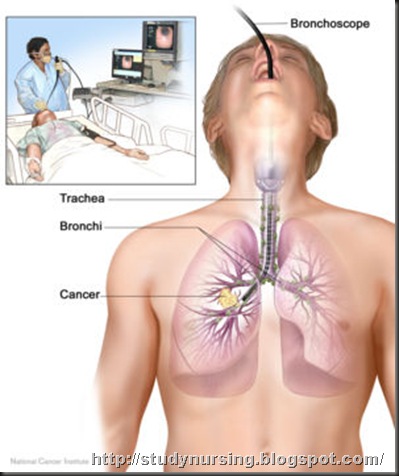Your doctor can examine the inside of your windpipe and bronchial tubes by passing a soft instrument through your nose or mouth into your lungs. This procedure is called a bronchoscopy (bron-KOS-ko-pee). Tissue may be removed through the instrument for tests in the lab.
Risks
There is a chance of injury to your throat, windpipe, or bronchial tubes. You might also bleed (hemorrhage), get an infection, or develop heart or lung problems. However, these problems are unlikely if you follow your doctor's directions.
IF YOU'RE HEADING FOR THE HOSPITAL...
Before You Go
- Your doctor will tell you when you must stop eating or drinking. Follow these directions exactly.
- You will need to remove earrings, necklaces, and other jewelry before the test.
- If you wear glasses, contact lenses, or false teeth, take them off just before the test.
What to Expect While You're There
You may encounter the following procedures and equipment during your stay:
- Taking Your Vital Signs: These include your temperature, blood pressure, pulse (counting your heartbeats), and respirations (counting your breaths). A stethoscope is used to listen to your heart and lungs. Your blood pressure is taken by wrapping a cuff around your arm.
- Pulse Oximeter: You may be hooked up to a pulse oximeter (ox-IM-uh-ter). It is placed on your ear, finger, or toe and is connected to a machine that measures the oxygen in your blood.
- IV: A tube placed in your vein for giving medicine or liquids. It will be capped or have tubing connected to it.
- During the Bronchoscopy...
- The test will take about an hour. You will be asked to lie down with a pillow under your head. Your doctor will put numbing medicine in your throat to prevent coughing or gagging.
- Your doctor will gently pass the bronchoscope (BRON-ko-scope)--a small tube with a light and lenses on the tip--through your mouth or nose and down your throat and windpipe.
- You may need to breathe through your nose if the tube is in your mouth. If the tube is in your nose, breathe through your mouth. You will get oxygen to help you breathe. Your throat may get dry. You will not be able to talk during the procedure.
- Your doctor will look closely at your windpipe and the small tubes leading to your lungs. A sample of your tissue or sputum may be sent to the lab for tests.
- You will be carefully watched for complications for a while after the test.
After You Leave
- The medicine given during the test will make you sleepy; do not drive for 12 hours after your test.
- You may resume normal activities as soon as you feel up to it.
- You may begin drinking or eating approximately 4 hours after the procedure.
- Take throat lozenges or gargle with salt water if your throat is sore. Taking liquids will help eliminate any dryness in your mouth or throat.
Call Your Doctor If...
- You have a high temperature.
Seek Care Immediately If...
- You begin to cough up blood.
- You have breathing problems or start wheezing.

No comments:
Post a Comment